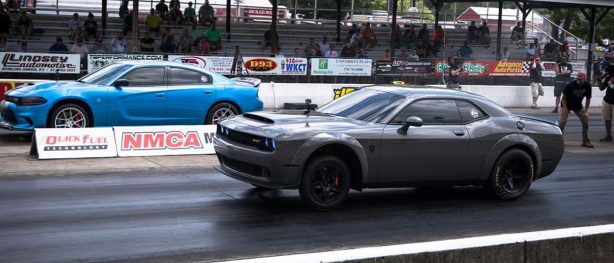A Year With the Dodge Challenger SRT® Demon – Five Things I’ve Learned as an Owner: Fact 4
Now that we have the mods out of the way, let’s talk about the suspension.
Fact 4:
One of my least favorite things about the car is probably the most key piece to the puzzle of how the Dodge Challenger SRT® Demon performs so well. I am talking about the suspension. Before you get all upset at the previous statement, let me explain. It’s obvious you can crank more power out of this power plant and the engineers could have cranked out more if they wanted to. But as you know, horsepower numbers don’t always equal results. A lot of attention was put into the suspension on the SRT Demon. When photos of production SRT Demons started making their way to the interwebs, I was slightly let down (along with many other people) at how the stance of the car looked more like that of a 4WD truck. It had hideous wheel gap and sits as high as the AWD models. Visually for me, I was really bummed out. It definitely did not have the refined stance like the SRT Hellcat or Viper. However, the magic sprinkles they put into this suspension makes you quickly forget about all of that. What the engineers did with the suspension of the SRT Demon is truly amazing. The best way to try to give you an idea via words on a screen is this: My SRT Hellcat made more horsepower than the SRT Demon, a significant amount more. The SRT Hellcat MIGHT pull 1.2G lateral G Forces on launch, with all that power. The SRT Demon: 1.8G on launch. While there are some other factors that play into that – such as torque converter stall and tuning – the majority of it is all coming from the magical suspension. And for those who don’t know, 1.2 to 1.8G is a significant difference in what you feel. Very few SRT Hellcats can pull the front wheels, even with lots of modifications. The SRT Demon, however, can pull the wheels up in stock form. What that translates to is the perfect amount of weight transfer to get the car to hook up and launch to its best potential. Pulling in low 1.3-second 60-foot times (a few have gotten 1.2 seconds with mods), while very few SRT Hellcats can even come close to that. Making more power in my SRT Hellcat, I couldn’t touch the 60-foot time, I couldn’t touch the G Force readings, and still couldn’t run the quarter-mile as fast as the SRT Demon could. I definitely think the suspension may be one of the most significant upgrades the SRT Demon has over the SRT Hellcat. So much so that people are now installing SRT Demon suspension springs on their SRT Hellcats to try to take advantage of the R&D the pros at Dodge/SRT put into picking that spec out.
As all race aficionados know, consistency is the key to winning a race. Next time, we will talk about the consistency of the Dodge Challenger SRT Demon.

0 Comments